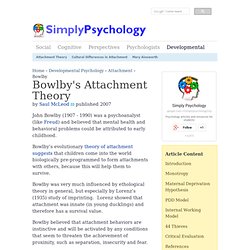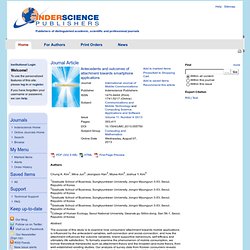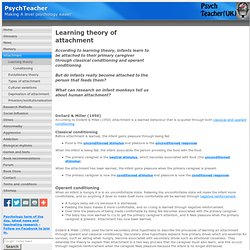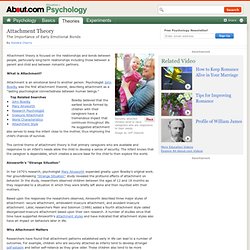

Child Development, Vol. 40, No. 4 (Dec., 1969), pp. 969-1025. Maternal Deprivation Theory. By Saul McLeod published 2007 John Bowlby (1907 - 1990) was a psychoanalyst (like Freud) and believed that mental health and behavioral problems could be attributed to early childhood.

Bowlby’s evolutionary theory of attachment suggests that children come into the world biologically pre-programmed to form attachments with others, because this will help them to survive. Bowlby was very much influenced by ethological theory in general, but especially by Lorenz’s (1935) study of imprinting. Lorenz showed that attachment was innate (in young ducklings) and therefore has a survival value. Bowlby believed that attachment behaviors are instinctive and will be activated by any conditions that seem to threaten the achievement of proximity, such as separation, insecurity and fear.
Bowlby (1969, 1988) also postulated that the fear of strangers represents an important survival mechanism, built in by nature. Main Points of Bowlby’s Theory 1. 2. 3. 4. They found 3 progressive stages for distress: 5. Antecedents and outcomes of attachment towards smartphone applications - International Journal of Mobile Communications - Volume 11, Number 4/2013. Journal Article Authors Chung K.

Kim1, Mina Jun2, Jeongsoo Han3, Miyea Kim4, Joshua Y. Kim5 1Graduate School of Business, Sungkyunkwan University, Jongro Myungyun 3-53, Seoul, Republic of Korea2Graduate School of Business, Sungkyunkwan University, Jongro Myungyun 3-53, Seoul, Republic of Korea3Graduate School of Business, Sungkyunkwan University, Jongro Myungyun 3-53, Seoul, Republic of Korea4Graduate School of Business, Sungkyunkwan University, Jongro Myungyun 3-53, Seoul, Republic of Korea5College of Human Ecology, Seoul National University, Gwanak-gu Sillim-dong, San 56-1, Seoul, Republic of Korea Abstract The purpose of this study is to examine how consumers' attachment towards mobile applications is influenced by the antecedent variables, self-connection and social-connection, and how the attachment influences the outcome variables, brand supportive behaviours, self-efficacy and ultimately life satisfaction. Keywords. Learning theory of attachment for A level psychology - Psychteacher.
Dollard & Miller (1950)According to Dollard & Miller (1950) attachment is a learned behaviour that is acquired through both classical and operant conditioning.

Classical conditioningBefore attachment is learned, the infant gains pleasure through being fed. Food is the unconditioned stimulus and pleasure is the unconditioned response.When the infant is being fed, the infant associates the person providing the food with the food.The primary caregiver is the neutral stimulus, which becomes associated with food (the unconditioned stimulus).When the attachment has been learned, the infant gains pleasure when the primary caregiver is present.The primary caregiver is now the conditioned stimulus and pleasure is now the conditioned response.Operant conditioningWhen an infant is hungry it is in an uncomfortable state.
Evaluating learning theory of attachmentLearning theory provides a very plausible and scientifically reliable explanation for attachment formation. Home. Explanations of attachment Why do babies form attachments?

Learning Theory According to behaviourists, behaviour is not innate but learned. Learning can be due to associations being made between different stimuli (classical conditioning) or behaviour can be altered by patterns of reinforcement (reward) and punishment (operant conditioning). Neo-behaviourists suggest that we learn by watching others (social learning theory or SLT). Note: think of conditioning as learning. Behaviourist explanations of attachment: Operant conditioning Dollard and Miller (1950) suggested that the attachment was due to drive reduction. Hunger and cold (discomfort) are referred to as primary drives and food and warmth are primary reinforcers. ‘Adoption and attachment theory’ the attachment models of adoptive mothers and the revision of attachment patterns of their late-adopted children - Pace - 2010 - Child: Care, Health and Development.
‘Adoption and attachment theory’ the attachment models of adoptive mothers and the revision of attachment patterns of their late-adopted children - Pace - 2010 - Child: Care, Health and Development. Attachment in Foster Care: The Role of Maternal Sensitivity, Adoption, and Foster Mother Experience. Attachment Theory: How Early Attachments Shape Behavior. Attachment theory is focused on the relationships and bonds between people, particularly long-term relationships including those between a parent and child and between romantic partners.

What is Attachment? Attachment is an emotional bond to another person. Psychologist John Bowlby was the first attachment theorist, describing attachment as a "lasting psychological connectedness between human beings. " Bowlby believed that the earliest bonds formed by children with their caregivers have a tremendous impact that continues throughout life. He suggested attachment also serves to keep the infant close to the mother, thus improving the child's chances of survival. The central theme of attachment theory is that primary caregivers who are available and responsive to an infant's needs allow the child to develop a sense of security.
Ainsworth's "Strange Situation" In her 1970's research, psychologist Mary Ainsworth expanded greatly upon Bowlby's original work.